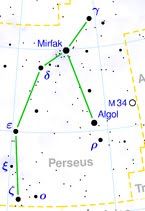Last month's constellation,
Cassiopeia - the "W", is almost directly overhead around 7 PM. If you
look slightly south and east of this W, you'll find Perseus. It is shaped like
a wishbone which points at Cassiopeia. The band of the Milky Way runs from
Cassiopeia through Perseus. (See last month's Constellation of the Month post
on this blog for more on the band of the Milky Way).
Perseus's brightest star, Algol,
is actually 3 stars. Two revolve around each other (actually around a point in
between them) and the 3rd moves along a large elliptical path outside the other
two. More than half the stars in our Milky Way galaxy are multiple stars
-- doubles, triples, sextuples, etc.
Algol is also a variable star
-- which are much less common than multiple stars. About every 3 days, Algol's
brightness drops by about 70%. This occurs when the larger, but fainter, star
passes in front (as viewed from the Earth) of the brighter star. In addition to
eclipsing variables like Algol, other variable stars are caused by pulsing -- a
star actually expands and shrinks periodically. The brightness of some variable
stars can vary by a factor or 1,000 or more in a period of less than a year.
Perseus is also home to M 34 --
an open cluster of about 400 stars, which is easily seen with binoculars. An open
cluster is a group of stars which were formed from the same nebula
(huge cloud of gasses) at roughly the same time -- about 200 million years ago
for M34. This is very young as stars go; the Sun is about 5 billion years old.
M34 appears to cover an area in the sky about the size of the full moon. It's
about 7 light years across, and about 1,500 light years away. A light year
is about 6 trillion miles, which is the distance light travels in one year. So,
when you're looking at this cluster, you're actually seeing it as it was 1,500
years ago.





No comments:
Post a Comment